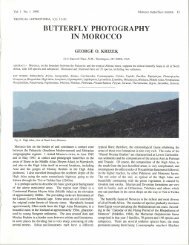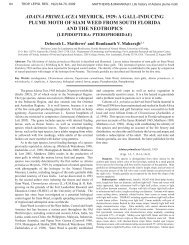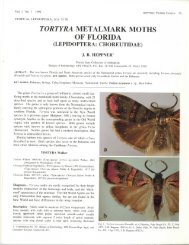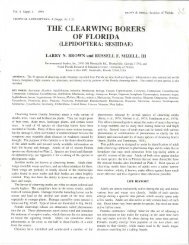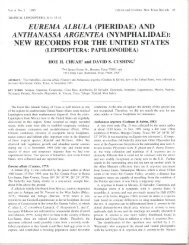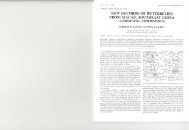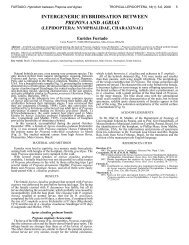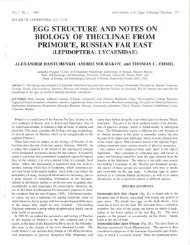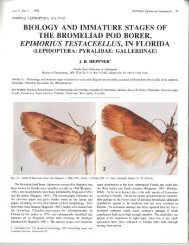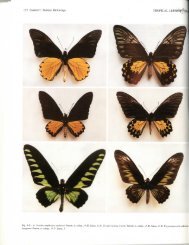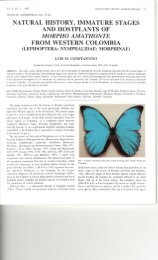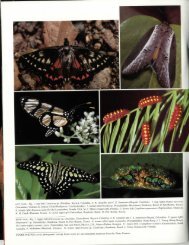Heppner, J. B. 1991. Brachyptery and aptery in Lepidoptera ...
Heppner, J. B. 1991. Brachyptery and aptery in Lepidoptera ...
Heppner, J. B. 1991. Brachyptery and aptery in Lepidoptera ...
Create successful ePaper yourself
Turn your PDF publications into a flip-book with our unique Google optimized e-Paper software.
Vol. 2 No. 1 1991 HEPPNER: <strong>Brachyptery</strong> 11<br />
TROPICAL LEPIDOPTERA, 2(1): 11-40<br />
BRACHYPTERY AND APTERY<br />
IN LEPIDOPTERA<br />
J. B. HEPPNER1<br />
Florida State Collection of Arthropods<br />
Bureau of Entomology, DPI, FDACS, P.O. Box 147100, Ga<strong>in</strong>esville, FL 32614, USA<br />
ABSTRACT.- The conditions of w<strong>in</strong>g reduction (brachyptery) <strong>and</strong> loss of w<strong>in</strong>gs (<strong>aptery</strong>), <strong>and</strong> modifications thereof, are reviewed across all known<br />
families of <strong>Lepidoptera</strong> where this has been observed <strong>in</strong> either males or females, or both sexes. <strong>Brachyptery</strong> or <strong>aptery</strong> is known <strong>in</strong> 35 families of<br />
<strong>Lepidoptera</strong>, <strong>in</strong>clud<strong>in</strong>g families or species where a k<strong>in</strong>d of brachyptery is only evident as extreme w<strong>in</strong>g reduction of the h<strong>in</strong>d w<strong>in</strong>gs. Examples from<br />
most families known to have brachyptery of some form are illustrated among 147 figures.<br />
KEY WORDS: Alucitidae, Anthelidae, Arctiidae, Blastobasidae, Brachodidae, Carpos<strong>in</strong>idae, Cosmopterigidae, Cossidae, Ctenuch<strong>in</strong>ae, Elachistidae,<br />
Epiplemidae, Eriocottidae, Gelechiidae, genetics, Geometridae, Glyphipterigidae, Gracillariidae, Hepialidae, Heterogynidae, Himantopteridae,<br />
Lasiocampidae, Lecithoceridae, Limacodidae, Lycaenidae, Lymantriidae, Lyonetiidae, Noctuidae, Notodontidae, Oecophoridae, Oxychirotidae,<br />
Papilionidae, Psychidae, Pterophoridae, Pyralidae, Scythrididae, Sesiidae, Somabrachyidae, Sph<strong>in</strong>gidae, Syntom<strong>in</strong>ae, Thyretidae, Thyrididae, T<strong>in</strong>eidae,<br />
Tortricidae, Yponomeutidae, Zygaenidae.<br />
<strong>Brachyptery</strong> (w<strong>in</strong>g reduction) or <strong>aptery</strong> (loss of w<strong>in</strong>gs) is an<br />
unusual phenomenon <strong>in</strong> adults among several orders of <strong>in</strong>sects<br />
(La Greca, 1954). In <strong>Lepidoptera</strong>, brachyptery has been reviewed<br />
most recently by Hackman (1966), Dierl <strong>and</strong> Reichhoff (1977),<br />
<strong>and</strong> by Huemer <strong>and</strong> Saltier (1989). Earlier comprehensive papers<br />
on brachyptery <strong>in</strong> <strong>Lepidoptera</strong> were by Chapman (1913, 1913a,<br />
1917), Hudson (1912), Jordan (1884), Knatz (1891), <strong>and</strong> Porritt<br />
(1913). <strong>Lepidoptera</strong> with some degree of w<strong>in</strong>g reduction or<br />
complete loss of w<strong>in</strong>gs <strong>in</strong> one or both sexes have been recorded<br />
now <strong>in</strong> 35 families (see Table 1):<br />
Hepialidae, T<strong>in</strong>eidae, Eriocottidae, Psychidae, Oecophoridae,<br />
Lecithoceridae, Elachistidae, Gelechiidae, Blastobasidae,<br />
Cosmopterigidae, Scythrididae, Carpos<strong>in</strong>idae, Glyphipterigidae,<br />
Yponomeutidae, Thyrididae, Pyralidae, Heterogynidae,<br />
Zygaenidae, Himantopteridae, Somabrachyidae, Cossidae,<br />
Limacodidae, Tortricidae, Papilionidae, Lycaenidae, Epiplemidae,<br />
Geometridae, Anthelidae, Lasiocampidae, Sph<strong>in</strong>gidae,<br />
Notodontidae, Thyretidae, Lymantriidae, Arctiidae, <strong>and</strong><br />
Noctuidae.<br />
Among most of these families, brachyptery is very rare (e.g.,<br />
Hepialidae, Pyralidae, Tortricidae, <strong>and</strong> Noctuidae), but <strong>in</strong> a few<br />
families, notably Psychidae, Heterogynidae, Somabrachyidae, <strong>and</strong><br />
Lymantriidae, it is very common for most species to have<br />
brachypterous females, many be<strong>in</strong>g apterous (Bourgogne, 1958;<br />
Buszko <strong>and</strong> Sliw<strong>in</strong>ski, 1980; Daniel <strong>and</strong> Dierl, 1966; Powell,<br />
1911; Zilli <strong>and</strong> Racheli, 1989). In some cases, complete brachyptery<br />
is not evident, but the h<strong>in</strong>dw<strong>in</strong>gs have extreme reduction <strong>in</strong><br />
size (e.g., some species of Lecithoceridae, Cosmopterigidae,<br />
Himantopteridae, Cossidae, Limacodidae, Geometridae, Sph<strong>in</strong>gidae,<br />
Notodontidae, Thyretidae <strong>and</strong> the arctiid subfamilies<br />
Ctenuch<strong>in</strong>ae <strong>and</strong> Syntom<strong>in</strong>ae). Not <strong>in</strong>cluded <strong>in</strong> this def<strong>in</strong>ition of<br />
1. Contribution No. 752, Bureau of Entomology. DPI, Florida Dept. Agric. <strong>and</strong><br />
Consumer Services, Ga<strong>in</strong>esville, FL.<br />
Female Orgyia sp. (Lymantriidae) on cocoon (Ga<strong>in</strong>esville, FL). © J. <strong>Heppner</strong><br />
brachyptery are species hav<strong>in</strong>g extremely narrow w<strong>in</strong>gs (stenopterous)<br />
as <strong>in</strong> many microlepidoptera, particularly <strong>in</strong> such families<br />
as Gracillariidae, Lyonetiidae, Cosmopterigidae, <strong>and</strong> Sesiidae, or<br />
such w<strong>in</strong>g modifications as <strong>in</strong> Alucitidae, Oxychirotidae, <strong>and</strong><br />
most Pterophoridae. Other families excluded from the def<strong>in</strong>ition<br />
of brachyptery <strong>in</strong>clude such families as Brachodidae, where the<br />
enlarged abdomens of the mostly sessile females (<strong>Heppner</strong>, 1983)<br />
of some European species give the appearance of a k<strong>in</strong>d of w<strong>in</strong>g<br />
reduction, yet where the ratio of female w<strong>in</strong>gs to male w<strong>in</strong>gs is<br />
not very much different from 1:1.
12 HEPPNER: <strong>Brachyptery</strong> TROPICAL LEPIDOPTERA<br />
Fig. 1. HEPIALIDAE: Pharmacis pyrenaicus (Donzel) 9, Spa<strong>in</strong>.<br />
Table 1 lists the known brachypterous <strong>and</strong> apterous species<br />
from a search of the literature <strong>and</strong> museum collections, yet some<br />
species may have been missed <strong>and</strong> many more will undoubtedly<br />
be added as additional searches are made of alp<strong>in</strong>e <strong>and</strong> xeric<br />
(eremic) regions where such species are most apt to be found.<br />
There also are other species known to be brachypterous from<br />
such places as the high elevations of the Rocky Mounta<strong>in</strong>s of<br />
North America, but which are not yet described (Hodges, <strong>in</strong>. litt.).<br />
Butterfly species, other than four Papilionidae <strong>and</strong> one Lycaenidae<br />
with relatively extreme h<strong>in</strong>dw<strong>in</strong>g reduction, or any of the<br />
most primitive moth families (four species of Hepialidae be<strong>in</strong>g<br />
the only known exceptions), do not exhibit any brachyptery, as<br />
opposed to mutations (Fig. 141-144) or rare eclosion accidents<br />
(Bowden, 1963; Shapiro, 1983). H<strong>in</strong>dw<strong>in</strong>g reduction <strong>in</strong>cluded <strong>in</strong><br />
Table 1 refers only to an extreme form, with a fore- to h<strong>in</strong>dw<strong>in</strong>g<br />
ratio of near 3:1 or more (a few cases are <strong>in</strong>cluded where there<br />
is h<strong>in</strong>dw<strong>in</strong>g reduction on the borderl<strong>in</strong>e of these criteria, notably<br />
<strong>in</strong> Zygaenidae, Papilionidae, Lycaenidae, <strong>and</strong> Sph<strong>in</strong>gidae).<br />
H<strong>in</strong>dw<strong>in</strong>g reduction is common among Syntom<strong>in</strong>ae <strong>and</strong> the<br />
Ctenuch<strong>in</strong>ae (Arctiidae), for example. One of the most extreme<br />
cases is a Brazilian species, Diptilon culex Draudt, where the<br />
reduced h<strong>in</strong>d w<strong>in</strong>gs are so small that they are hidden among the<br />
thoracic scales at the w<strong>in</strong>g bases (Draudt, 1915); other Diptilon<br />
species (Fig. 123-126) also show some h<strong>in</strong>dw<strong>in</strong>g reduction. In<br />
T<strong>in</strong>eidae there is at least one extreme example, the species<br />
Meessia brachyptera Passar<strong>in</strong> d'Entreves, where the forew<strong>in</strong>gs of<br />
the female are only slightly reduced but the h<strong>in</strong>dw<strong>in</strong>gs are m<strong>in</strong>ute<br />
(Fig. 2). Other families with examples can be noted <strong>in</strong> Table 1.<br />
The development of w<strong>in</strong>g reduction only <strong>in</strong> the h<strong>in</strong>dw<strong>in</strong>gs is<br />
curious <strong>and</strong> appears without apparent reason <strong>in</strong> <strong>Lepidoptera</strong> other<br />
than possibly be<strong>in</strong>g sexually derived, s<strong>in</strong>ce among several groups<br />
the females have more developed h<strong>in</strong>dw<strong>in</strong>gs <strong>and</strong> only the males<br />
have markedly reduced h<strong>in</strong>dw<strong>in</strong>gs. Cases of reduced forew<strong>in</strong>gs<br />
are known <strong>in</strong> some families (e.g., Dismorphi<strong>in</strong>ae <strong>in</strong> Pieridae), but<br />
this really is narrow<strong>in</strong>g of the forew<strong>in</strong>gs, or enlargement of the<br />
h<strong>in</strong>dw<strong>in</strong>gs, <strong>and</strong> not a k<strong>in</strong>d of brachyptery as considered here.<br />
<strong>Brachyptery</strong> usually occurs only <strong>in</strong> the female but it has been<br />
recorded <strong>in</strong> both sexes <strong>in</strong> a few cases, primarily <strong>in</strong> moths from<br />
isolated oceanic isl<strong>and</strong>s: the Kerguelen Is. (Viette, 1948) <strong>and</strong><br />
Heard Id. (Common, 1970) of the south Indian Ocean; the<br />
Antipodes Is. (Salmon <strong>and</strong> Bradley, 1956), Auckl<strong>and</strong> Isl<strong>and</strong>s<br />
(Dugdale, 1971), <strong>and</strong> Campbell Id. (Dugdale, 1964; Viette, 1954)<br />
near New Zeal<strong>and</strong>; <strong>and</strong> the Falkl<strong>and</strong> Is. (Bradley, 1965) of the<br />
south Atlantic Ocean. Families from these isl<strong>and</strong> faunas of<br />
brachypterous moths <strong>in</strong>clude T<strong>in</strong>eidae, Oecophoridae, Elachistidae,<br />
Yponomeutidae, Tortricidae, <strong>and</strong> Pyralidae. The only known<br />
species with brachypterous w<strong>in</strong>gs <strong>in</strong> both sexes from a cont<strong>in</strong>ental<br />
area, although from coastal s<strong>and</strong> dunes, is a species of Scythrididae,<br />
Areniscythris brachypteris Powell (Fig. 26), from California<br />
(Powell, 1976). Another undescribed s<strong>and</strong> dune scythrid appears<br />
to reside <strong>in</strong> coastal dunes of western Florida. Both scythrid<br />
species are unusual <strong>in</strong> the construction of larval s<strong>and</strong> tubes of silk<br />
at the base of their host plant. Hackman (1966) referred to a<br />
Gelechiidae species from Morocco, Ephysteris curtipennis<br />
(Zerny), as another cont<strong>in</strong>ental species where both sexes are<br />
brachypterous, but although the male does have extremely<br />
narrowed w<strong>in</strong>gs (stenopterous), Povolny (1968) noted that the<br />
males of this species can fly.<br />
<strong>Brachyptery</strong> on both fore- <strong>and</strong> h<strong>in</strong>dw<strong>in</strong>gs, or even complete<br />
w<strong>in</strong>g loss, is most common <strong>in</strong> females. This condition is normal<br />
<strong>in</strong> the families of Lymantriidae, Somabrachyidae, <strong>and</strong> Psychidae.<br />
Likewise, it is a regular occurrence among many primitive<br />
T<strong>in</strong>eoidea. Typically, the females are relatively immobile <strong>in</strong><br />
these groups, often sequestered with<strong>in</strong> the larval <strong>and</strong> pupal case,<br />
as <strong>in</strong> the example of the Psychidae or bagworms. All are<br />
terrestrial except for one case of brachyptery among the few<br />
known aquatic moths <strong>in</strong> the family Pyralidae: Acentria ephemerella<br />
(Denis <strong>and</strong> Schiffermiiller) [formerly Acentropus nivea<br />
(Olivier)] (Fig. 43). In the case of this aquatic moth, the female<br />
is dimorphic, with some females of a population fully w<strong>in</strong>ged <strong>and</strong><br />
others almost apterous (Berg, 1941).<br />
Female w<strong>in</strong>g reduction <strong>in</strong> <strong>Lepidoptera</strong> is rarely polymorphic.<br />
The dimorphic example of the aquatic moth, Acentria ephemerella<br />
(Pyralidae), has already been noted. Another form of<br />
facultative w<strong>in</strong>g reduction occurs <strong>in</strong> a few species hav<strong>in</strong>g seasonal<br />
forms, one generation hav<strong>in</strong>g fully w<strong>in</strong>ged females <strong>and</strong> another<br />
generation hav<strong>in</strong>g brachypterous or apterous females; this w<strong>in</strong>g<br />
reduction is usual among some species with autumn or w<strong>in</strong>ter<br />
generations <strong>in</strong> temperate climates (Kimura <strong>and</strong> Masaki, 1977;<br />
Sachrov, 1914). W<strong>in</strong>g reduction polyphenism of this k<strong>in</strong>d is<br />
prevalent <strong>in</strong> some Lymantriidae, e.g., Orgyia thyell<strong>in</strong>a Butler<br />
(Cretschmar, 1928). In Thaumetopoea species (Notodontidae)<br />
females usually are w<strong>in</strong>ged but can be brachypterous on occasion<br />
(Loritz, 1952). W<strong>in</strong>g reduction <strong>in</strong> geographical variation is rare:<br />
an example is the arctic geometrid Psychophora sab<strong>in</strong>ii Curtis,<br />
where the females have some w<strong>in</strong>g reduction on the Pribilof Is.,<br />
Alaska, but elsewhere are fully w<strong>in</strong>ged (Downes, 1964, 1965).<br />
The same occurs with the arctic arctiid, Pararctia subnebulosa<br />
(Dyar) (Sotavalta, 1965). Another case of geographic brachyptery<br />
occurs <strong>in</strong> the geometrid Lycia hirtaria (Clerck), females be<strong>in</strong>e
Vol. 2 No. 1 1991 HEPPNER: <strong>Brachyptery</strong> 13<br />
Fig. 2-5. TINEIDAE: 2. Meessia braehyptera.Passer<strong>in</strong> d'Entreves
14 HEPPNER: <strong>Brachyptery</strong> TROPICAL LEPIDOPTERA<br />
So R.I.<br />
R2.+3.<br />
Fig. 6-11. TINEIDAE: 6. Pr<strong>in</strong>gleophaga kerguelensis Enderle<strong>in</strong>
Vol. 2 No. 1 1991 HEPPNER: <strong>Brachyptery</strong> 15<br />
Fig. 12-17. PSYCHIDAE: 12. Taleporia tuhulosa (Retzius) tf. USSR; 13. same 9, USSR; 14. Solenobia cembrella (L<strong>in</strong>naeus)
16 HEPPNER: <strong>Brachyptery</strong> TROPICAL LEPIDOPTERA<br />
Fig. 18-22. PSYCHIDAE: 18. Acanrhopsyche nipae Bourgogne $, France; 19. Psyche crassiorella Bru<strong>and</strong> 9, France; 20. Eumeta rougeoti Bourgogne $ (dorsal viev<br />
Nigeria; 21. Eumeta cerv<strong>in</strong>a (Druce) $ (head <strong>and</strong> thorax profile) Nigeria; 22. Fumea casta (Pallas) 9, USSR [Fig. 18-19 after Bourgogne (1958); 20-21 after Entwistle<br />
(1963); 22 after Kozhanchikov (1956)].<br />
of brachyptery among isl<strong>and</strong> dwellers <strong>and</strong> coastal areas, however,<br />
may have developed w<strong>in</strong>g reduction due to other environmental<br />
parameters, notably thermoregulation or w<strong>in</strong>d adaptation (Powell,<br />
1976). <strong>Brachyptery</strong> among the aquatic Pyralidae undoubtedly is<br />
due to some adaptive advantage under water, possibly easier<br />
movement for oviposition, although there may be some offsett<strong>in</strong>g<br />
factor <strong>in</strong> the reduction <strong>in</strong> underwater air retention beneath normal<br />
folded w<strong>in</strong>gs as is prevalent <strong>in</strong> some other Nymphul<strong>in</strong>ae pyralids<br />
which also dive underwater to oviposit (Berg, 1941).<br />
In <strong>Lepidoptera</strong>, part of the probable evolutionary development<br />
of w<strong>in</strong>g reduction <strong>in</strong> females <strong>in</strong>volves two modes of brachypterous<br />
females (Hackman, 1966): 1) the case where females have<br />
developed enlarged abdomens with many eggs prior to oviposition,<br />
mak<strong>in</strong>g flight difficult; <strong>and</strong> 2) the case where females have<br />
a normal abdom<strong>in</strong>al size <strong>and</strong> are mobile, thus capable of rapid<br />
flight when desired. The Psychidae females <strong>and</strong> some Lymantriidae<br />
are examples of the former type <strong>and</strong> such moths as the<br />
scythrid, Areniscythris, are typical of the latter type. A development<br />
towards brachyptery may be evident <strong>in</strong> species like the<br />
European arctiid Artimelia hemigena (Grasl.) (Fig. 109-110) or<br />
the noctuid Agrotis fatidica (Hiibner) (Fig. 132-133): these<br />
species are listed <strong>in</strong> Table 1 as brachypterous, but the females<br />
have only somewhat reduced w<strong>in</strong>gs. Given this range of<br />
brachypterous females, considerable speculation has been made<br />
as to the development of brachyptery <strong>in</strong> <strong>Lepidoptera</strong>. Theories<br />
have been proposed by Naumann (1937), Eggers (1939), <strong>and</strong><br />
Downes (1964). Their ma<strong>in</strong> po<strong>in</strong>ts perta<strong>in</strong> to a development of<br />
brachyptery <strong>in</strong> response to decreased mobility due to abdom<strong>in</strong>al<br />
enlargement from excessive egg numbers, with adaptive mutations<br />
progress<strong>in</strong>g to brachypterous or apterous forms. A number of<br />
species worldwide exhibit enlarged abdomens <strong>in</strong> the female,<br />
result<strong>in</strong>g <strong>in</strong> reduced flight or little apparent flight: e.g., females<br />
of the Great Bas<strong>in</strong> tortricid, Synnoma lynosyrana Wals<strong>in</strong>gham,<br />
have an enlarged abdomen prior to egg lay<strong>in</strong>g <strong>and</strong> do not readily<br />
fly (Powell, pers. comm.). Among Brachodidae, the Palearctic<br />
genus Brachodes has females that are relatively sedentary prior<br />
to copulation <strong>and</strong> only fly for egg lay<strong>in</strong>g (<strong>Heppner</strong>, 1983;<br />
<strong>Heppner</strong> <strong>and</strong> Duckworth, 1981).<br />
As noted previously, <strong>in</strong> various habitats (cold regions, high<br />
altitudes, eremic regions, <strong>and</strong> coastal areas) there appear to be<br />
adaptive benefits to brachyptery. Hackman (1966) notes,<br />
however, that the evolution of extreme w<strong>in</strong>g reduction <strong>in</strong> some of<br />
the almost larviform females of Lymantriidae (Fig. 102-108) <strong>and</strong><br />
Psychidae (Fig. 18-22) is not easily expla<strong>in</strong>ed. The more mobile<br />
type of brachypterous female is also not expla<strong>in</strong>ed by the<br />
Naumann-Eggers-Downes theory, as Hackman (1966) calls it,
Vol. 2 No. 1 1991 HEPPNER: <strong>Brachyptery</strong> 17<br />
Fig. 23-25.2. OECOPHORIDAE: 23. Thyrocopa apatela (Wals<strong>in</strong>gham) 9, Hawaii; 24. same, w<strong>in</strong>g venation; 25. Borkhausenia falkl<strong>and</strong>ensis Bradley
18 HEPPNER: <strong>Brachyptery</strong> TROPICAL LEPIDOPTERA<br />
Fig. 26-28. SCYTHRIDIDAE: 26. Areniscythris brachypteris Powell 9, USA (California); YPONOMEUTIDAE: 27. Embryonopsis halticella Eaton cf, Marion Is.;<br />
28. same, w<strong>in</strong>g venation [Fig. 26 after Powell (1976); 27 after Viette (1948); 28 after Common (1970)].<br />
s<strong>in</strong>ce three types of these mobile forms are evident: 1) arboricolous<br />
cold-season species; 2) terricolous species; <strong>and</strong> 3) aquatic<br />
species (<strong>in</strong> this last case, only Acentria ephemerella is known).<br />
Additional theories of the evolution of brachyptery <strong>in</strong> these forms<br />
<strong>in</strong>volve environmental adaptations (e.g., thermoregulation,<br />
protection from high w<strong>in</strong>d, cold stupor, etc.), whereby sedentary<br />
females rema<strong>in</strong> on or near host plants (Chapman, 1913; Hudson,<br />
1912; Wood, 1913). Additionally, there is predator evasion as a<br />
probable adaptive advantage for many brachypterous species (e.g.,<br />
Sattleria dzieduszycskii (Nowicki)) which hide <strong>in</strong> low alp<strong>in</strong>e<br />
plants (Hackman, 1966). W<strong>in</strong>g reduction <strong>in</strong> the aquatic species<br />
is likewise not easily expla<strong>in</strong>ed by the above theories, although<br />
environmental adaptation for oviposition would seem to be the<br />
cause, but this unique case is more complex due to the dimorphic<br />
female, which may be fully w<strong>in</strong>ged or brachypterous with<strong>in</strong> the<br />
same population <strong>and</strong> generation.<br />
Species listed <strong>in</strong> Table 1 are brachypterous to fully apterous<br />
(usually only females) <strong>in</strong> one or both sexes (M or F), or have an<br />
extreme degree of h<strong>in</strong>dw<strong>in</strong>g reduction (*). Examples listed<br />
hav<strong>in</strong>g only h<strong>in</strong>dw<strong>in</strong>g reduction usually are <strong>in</strong>cluded only if this<br />
condition is extreme (fore- to h<strong>in</strong>dw<strong>in</strong>g ratio of 3:1 or more) but<br />
a few borderl<strong>in</strong>e cases are <strong>in</strong>cluded where some h<strong>in</strong>dw<strong>in</strong>g<br />
reduction is evident (especially, Zygaenidae, Papilionidae,<br />
Lycaenidae, <strong>and</strong> Sph<strong>in</strong>gidae). The range of each taxon is noted<br />
to the far right of each name. A few species are facultatively<br />
brachypterous, where only some <strong>in</strong>dividuals develop this condition,<br />
<strong>and</strong> this is noted after the name; facultative here also<br />
<strong>in</strong>cludes cases where a species has brachyptery only <strong>in</strong> parts of<br />
its range (e.g., Psychophora sab<strong>in</strong>ii, <strong>in</strong> Geometridae). Names<br />
listed <strong>in</strong> Table 1 are considered valid here<strong>in</strong>, but various researchers<br />
may list some of them as synonyms (e.g., Phigalia <strong>in</strong><br />
Geometridae is used as a valid genus for Nearctic species, yet it<br />
is listed as a synonym of Apocheima by many European workers).<br />
Faunal literature has been searched for all known references to<br />
brachypterous <strong>Lepidoptera</strong> (Bradley, 1958, 1965; Burmann, 1951,<br />
1954, 1956, 1957, 1958, 1973, 1977; Chapman, 1913a; Chauv<strong>in</strong><br />
<strong>and</strong> Vernon, 1981; Common, 1970; Comstock, 1940; Cotty <strong>and</strong><br />
Dethier, 1981; Diakonoff, 1973, 1983; Draudt, 1915; Dugdale,<br />
28
Vol. 2 No. 1 1991 HEPPNER: <strong>Brachyptery</strong> 19<br />
Fig. 29-36. OECOPHORIDAE: 29. Atomotricha versuta Meyrick
20 HEPPNER: <strong>Brachyptery</strong> TROPICAL LEPIDOPTERA<br />
Fig. 37-40. COSSIDAE: 37. Callocossus hyal<strong>in</strong>ipennis Str<strong>and</strong>
Vol. 2 No. 1 1991 HEPPNER: <strong>Brachyptery</strong> 21<br />
Table. 1. BRACHYPTEROUS LEPIDOPTERA OF THE<br />
WORLD<br />
HEPIALIDAE<br />
Aoraia senex (Hudson)<br />
Pharmacis anselm<strong>in</strong>ae (Teobaldelli)<br />
Pharmacis bertr<strong>and</strong>i (Le Cerf)<br />
Pharmacis pyrenaicus (Donzel)<br />
TINEIDAE<br />
Meessia brachyptera Passar<strong>in</strong> d'Entreves<br />
Pararhodobates syriacus (Lederer)<br />
Pr<strong>in</strong>gleophaga crozetensis Enderle<strong>in</strong><br />
Pr<strong>in</strong>gleophaga kerguelensis Enderle<strong>in</strong><br />
Proterodesma turbotti (Salmon & Bradley)<br />
T<strong>in</strong>ea allomella Bradley<br />
IT<strong>in</strong>ea amphitrite Meyrick<br />
ERIOCOTTIDAE<br />
Deuterot<strong>in</strong>ea casanella Eversmann<br />
Deuterot<strong>in</strong>ea stschetk<strong>in</strong>i Zagulayev<br />
PSYCHIDAE<br />
(all species except Penestogloss<strong>in</strong>ae)<br />
OECOPHORIDAE<br />
Atomotricha spp.<br />
Borkhausenia falkl<strong>and</strong>ensis Bradley<br />
Cheimophila spp.<br />
Chersadaula ochrogastra Meyrick<br />
Diurnea spp.<br />
Ethmia charybdis Powell<br />
Oxythecta austr<strong>in</strong>a Meyrick<br />
Pleurota rostrella (Hiibner)<br />
Proteodes clarkei Philpott<br />
T<strong>in</strong>earupa sorenseni Salmon & Bradley<br />
Thyrocopa apatella (Wals<strong>in</strong>gham)<br />
Xenomicta spp.<br />
LECITHOCERIDAE<br />
*Ceuthomadarus spp.<br />
*Lecithocera brachyptila Diakonoff<br />
ELACHISTIDAE<br />
Biselachista brachypterella (Klimesch)<br />
Irenicodes galatheae (Viette)<br />
Irenicodes holdgatei (Bradley)<br />
Irenicodes hookeri Dugdale<br />
Irenicodes pumila Dugdale<br />
GELECHIIDAE<br />
Acompsia dimorpha Petry<br />
Caryocolum laceratella (Zeller)<br />
Ephysteris curtipennis (Zerny)<br />
Ephysteris sp.<br />
Eulamprotes libert<strong>in</strong>ella (Zeller)<br />
Gelechia dzieduszynskii Burmann<br />
Gnorimoschema spp.<br />
llseopsis spp.<br />
Kiwaia jeanae Philpott<br />
*Megacraspedus spp.<br />
Opacopsis spp.<br />
F<br />
F<br />
F<br />
F<br />
New Zeal<strong>and</strong><br />
Alps<br />
Alps<br />
Spa<strong>in</strong><br />
F USSR<br />
F Syria/USSR<br />
M/F Crozet Is.<br />
M/F Kerguelen Is.<br />
M/F Antipodes Is.<br />
F Ug<strong>and</strong>a<br />
F Ug<strong>and</strong>a<br />
F USSR<br />
F USSR<br />
F<br />
M/F<br />
F<br />
F<br />
F<br />
F<br />
F<br />
F<br />
F<br />
M/F<br />
M/F<br />
F<br />
F<br />
F<br />
world<br />
New Zeal<strong>and</strong><br />
Falkl<strong>and</strong> Is.<br />
Palearctic<br />
New Zeal<strong>and</strong><br />
Palearctic<br />
USA (California)<br />
New Zeal<strong>and</strong><br />
Europe<br />
New Zeal<strong>and</strong><br />
Campbell Id.<br />
Hawaii<br />
Europe<br />
Morocco/Europe<br />
New Gu<strong>in</strong>ea<br />
F Italy<br />
M/F Campbell Id.<br />
M/F Falkl<strong>and</strong> Is.<br />
M/F Auckl<strong>and</strong> Is.<br />
M/F Auckl<strong>and</strong> Is.<br />
F Spa<strong>in</strong>/France<br />
F Alps<br />
F Morocco<br />
M/F Madeira<br />
F Alps<br />
F Austria<br />
F Europe<br />
F Palearctic<br />
M/F New Zeal<strong>and</strong><br />
F Europe<br />
F Europe<br />
Paraschema detectendum Povolny<br />
Sattleria spp.<br />
BLASTOBASIDAE<br />
Symmoca profanella Zerny<br />
Symmoca signella (Hiibner)<br />
Symmoca umbr<strong>in</strong>ella Zemy<br />
COSMOPTERIGIDAE<br />
*Stagmatophora extremella Klimesch<br />
SCYTHRIDIDAE<br />
Areniscythris brachypteris Powell<br />
lAreniscythris sp.<br />
Scythris sp.<br />
CARPOSINIDAE<br />
Campbellana atennuata Salmon & Bradley<br />
GLYPHIPTERIGIDAE<br />
Glyphipterix rugata Meyrick<br />
Glyphipterix xestobela Meyrick<br />
YPONOMEUTIDAE<br />
Embryonopsis halticella Eaton<br />
Kessleria pyrenaea Friese<br />
Kessleria zimmermannii (Nowicki)<br />
THYRIDIDAE<br />
*Glanycus foochowensis Chu & Wang<br />
*Glanycus <strong>in</strong>solitus Walker<br />
*Glanycus tricolor Moore<br />
*Meskea spp.<br />
PYRALIDAE<br />
Acentria ephemerella (D. & S.) [facultative]<br />
Cledeobia oculatalis Ragonot<br />
Exsilirarcha gram<strong>in</strong>ea Salmon & Bradley<br />
Protyparcha scaphodes Meyrick<br />
Pseudoschoenobius opalescalis (Hulst)1<br />
HETEROGYNIDAE<br />
Heterogynis penella Hiibner<br />
Heterogynis spp.<br />
Janseola titaea Druce<br />
ZYGAENIDAE2<br />
*Harris<strong>in</strong>a americana (Guer<strong>in</strong>-Meneville)<br />
*Pampa spp.<br />
*Pryeria s<strong>in</strong>ica Moore<br />
*Stylura drama (Druce)<br />
*Thyrassia penangae Moore<br />
*Triprocris flavipuncta Tarmann<br />
HIMANTOPTERIDAE<br />
*Doratopteryx spp.<br />
*Himantopterus fusc<strong>in</strong>ervis Wesm<br />
*Pseudothymara staud<strong>in</strong>geri Rogh<br />
*Semioptila spp.<br />
*Thymara spp.<br />
SOMABRACHYIDAE<br />
Somabrachys spp.<br />
F Bolivia<br />
F Alps<br />
F Morocco<br />
F Alps<br />
F Morocco<br />
Europe<br />
M/F USA (California)<br />
M/F USA (Florida)<br />
F New Zeal<strong>and</strong><br />
M/F Campbell Id.<br />
F New Zeal<strong>and</strong><br />
F New Zeal<strong>and</strong><br />
M/F Marion Id.<br />
F France<br />
F Pol<strong>and</strong><br />
M Ch<strong>in</strong>a<br />
M se. Asia<br />
M India<br />
M/F Neotropics<br />
F Europe<br />
F Morocco<br />
M/F Campbell Id.<br />
F New Zeal<strong>and</strong><br />
F USA (California)<br />
F Europe<br />
F Europe<br />
F South Africa<br />
M/F e. USA<br />
M/F Brazil<br />
M/F Ch<strong>in</strong>a/Japan<br />
M Guatemala<br />
M se. Asia<br />
M/F Brazil<br />
M/F Africa<br />
M/F se. Asia<br />
M/F Sierra Leone<br />
M/F Africa<br />
M/F India<br />
N. Africa
22 HEPPNER: <strong>Brachyptery</strong> TROPICAL LEPIDOPTERA<br />
COSSIDAE<br />
*Callocossus hyal<strong>in</strong>ipennis Str<strong>and</strong><br />
*Eulophonotus myrmeleon Felder<br />
*Eulophonotus obesus Karsch<br />
*Pyraphlecta melissodes Tarns<br />
*Zeuzera nigra Moore<br />
*Zeu:erops hyal<strong>in</strong>ipennis Str<strong>and</strong><br />
LIMACODIDAE<br />
*Cheromettia spp.<br />
*Doratifera nagod<strong>in</strong>a Her<strong>in</strong>g<br />
*Phobetron pithecium (Smith)<br />
*Pseudopsyche dembowskii Oberthiir<br />
*Sib<strong>in</strong>e auromacula Schaus<br />
TORTRICIDAE<br />
*Allodemis stegopa DIakonoff<br />
*Archilobesia drymoptila (Meyrick)<br />
*Borneogena antigrapha Diakonoff<br />
Euledereria alpicolana (Frolich)<br />
Exapate congelatella (Clerck)<br />
Exapate duratella Heydenreich<br />
Olethreutes orestera Bradley<br />
Oxypteron impar Staud<strong>in</strong>ger<br />
Sorensenata agilitata Salmon & Bradley<br />
*Theorica lamyra (Meyrick)<br />
*Xenolepis dolichoschiza Diakonoff<br />
PAPILIONIDAE<br />
*Parides hahneli Staud<strong>in</strong>ger<br />
*Parides tiopas Godart<br />
*Ornithoptera meridionalis Rothschild<br />
*Ornithoptera paradisea Staud<strong>in</strong>ger<br />
LYCAENIDAE<br />
*Syrmatia dorilas (Cramer)<br />
EPIPLEMIDAE<br />
*Aphyodes pilosa Warren<br />
*Nyctibadistes <strong>in</strong>formis Warren<br />
*Nyctibadistes nigrata Warren<br />
GEOMETRIDAE<br />
Agriopis spp. [some spp.]<br />
Alsophila spp.<br />
Amorphogynia spp.<br />
Animomyia spp.<br />
Apocheima spp.<br />
Asaphodes spp.<br />
Asaphodes oxptera (Hudson)<br />
Biclavigera spp.<br />
*Brabira apatopleura Prout<br />
*Cheimoptena pennigera Danilevsky<br />
Chondrosoma fiduciaria Anker<br />
*Dypteris abortivaria Herrich-Schaffer<br />
*Dystypoptila hebes Prout<br />
Egea spp.<br />
Elophos spp.<br />
Erannis spp.<br />
*Erate<strong>in</strong>a spp. [some spp.]<br />
*Eupithecia spp. [some spp.]<br />
*Hydrelia sylvata (D. & S.)<br />
*ldaea furciferata Packard<br />
M Malawi<br />
M South Africa<br />
M Ghana<br />
M/F Ug<strong>and</strong>a<br />
M India<br />
M Africa<br />
M se. Asia<br />
M New Gu<strong>in</strong>ea<br />
M USA<br />
M/F USSR/Korea<br />
M Venezuela<br />
M Sumatra<br />
M Australia<br />
F Borneo/Sumatra<br />
F Europe<br />
F Europe<br />
F Alps<br />
F Ug<strong>and</strong>a<br />
F USSR<br />
M/F Campbell Id.<br />
M New Gu<strong>in</strong>ea<br />
M Indonesia<br />
M/F Brazil<br />
M/F Guyana<br />
M New Gu<strong>in</strong>ea<br />
M New Gu<strong>in</strong>ea<br />
M<br />
M<br />
M<br />
M<br />
Brazil<br />
Peru<br />
Peru<br />
Peru<br />
F Europe<br />
F world<br />
F Europe<br />
F USA<br />
F Old World<br />
F New Zeal<strong>and</strong><br />
M/F Auckl<strong>and</strong> Is.<br />
F South Africa<br />
M Fiji<br />
M/F USSR<br />
F Europe<br />
M/F USA<br />
M Sulawesi<br />
F USSR<br />
F Europe<br />
F world<br />
M/F South America<br />
M world<br />
F Europe<br />
M USA<br />
Inurois spp.<br />
Itame loricaria (L<strong>in</strong>naeus)<br />
Ithysia pravata Hiibner<br />
Larerannis spp.<br />
Lignyoptera fumidaria (Hiibner)<br />
Lignyoptera thaumastaria Rebel<br />
Lycia spp.<br />
Lycia hirtaria (Clerck) [facultative]<br />
Malacodea regularia Tengstrom<br />
Microbiston spp.<br />
Napocheima rob<strong>in</strong>iae Chu<br />
Nyssiodes spp.<br />
Operophtera spp.<br />
Pachyerannis obliquaria (Motschulsky)<br />
Paleacrita spp.<br />
Palaeonysia trisecta Warren<br />
Phigalia spp.<br />
Phigaliohybernia fulv<strong>in</strong>fula Inoue<br />
Phthorarcha spp.<br />
Protalcis conc<strong>in</strong>nata (Wileman)<br />
Psychophora sab<strong>in</strong>ii Curtis [facultative]<br />
Pygmaena fusca (Thunberg)<br />
*Remodes remodesaria (Walker)<br />
*Remodes triseriata Moore<br />
*Rheumaptera hastata (L<strong>in</strong>naeus) [facultative]<br />
*Sauris spp. [some spp.]<br />
*Sauris <strong>in</strong>terrupta Moore<br />
Sciadia tenebraria (Esper)<br />
Sebastosema bubonaria Warren<br />
Somatolophia cuyama Comstock<br />
Spartopteiyx spp.<br />
Sucra jujuba Chu<br />
*Tatosoma tipulata (Walker)<br />
Theria spp.<br />
Xanthorrhoe spp. [some spp.]<br />
Yala pyricola Chu<br />
Zamacra spp.<br />
Zermiz<strong>in</strong>ga <strong>in</strong>docilisaria Walker<br />
ANTHELIDAE<br />
Pterolocera amplicornis Walker<br />
Pterolocera capnospila Turner<br />
LASIOCAMPIDAE<br />
Artace itatiaya Schaus<br />
*Borocera spp. [some spp.]<br />
Chondrostega spp.<br />
*Gonometa fulvida (Distant)<br />
*Gonometa postica Walker<br />
Laruma heterogenea Walker<br />
Lasiocampa staud<strong>in</strong>geri Baker<br />
*Melopla abhorrens Lajonquiere<br />
*Mesocelis montana (Stoll)<br />
*Nadiasa polydora (Druce)<br />
*Nadiasa uniformis (Aurivillius)<br />
*Neoborocera esteban (Dogn<strong>in</strong>)<br />
*Paradoxopla card<strong>in</strong>alis Holloway<br />
*Phoenicladocera parv<strong>in</strong>ota (Her<strong>in</strong>g)<br />
*Streblota p<strong>and</strong>a (Hiibner)<br />
*Suana concolor Walker<br />
*Suana divisa (Moore)<br />
*Ticera castanea Sw<strong>in</strong>hoe<br />
F Japan<br />
F Europe<br />
F Europe<br />
F Palearctic<br />
F Europe<br />
F Europe<br />
F Europe/Nearctic<br />
F Palearctic<br />
F F<strong>in</strong>l<strong>and</strong><br />
F USSR<br />
F Ch<strong>in</strong>a<br />
F USSR<br />
F world<br />
F e. Asia<br />
F Nearctic<br />
F Europe<br />
F Nearctic<br />
F Japan<br />
F USSR<br />
F Japan<br />
F Pribilof Is.<br />
F Europe<br />
M Sri Lanka<br />
M Sri Lanka<br />
F Europe<br />
M se. Asia/Fiji<br />
M/F se. Asia<br />
F Europe<br />
F Japan<br />
F USA (California<br />
F USSR<br />
F Ch<strong>in</strong>a<br />
M New Zeal<strong>and</strong><br />
F Europe<br />
F Africa<br />
F Ch<strong>in</strong>a<br />
F Europe<br />
F New Zeal<strong>and</strong><br />
F<br />
F<br />
F<br />
M<br />
F<br />
M<br />
M<br />
F<br />
F<br />
M<br />
F<br />
M<br />
M<br />
M<br />
M<br />
M<br />
M<br />
M<br />
M<br />
M<br />
Australia<br />
Australia<br />
Brazil<br />
Madagascar<br />
Europe<br />
South Africa<br />
South Africa<br />
Venezuela<br />
Algeria<br />
Madagascar<br />
South Africa<br />
c. Africa<br />
South Africa<br />
Ecuador<br />
Borneo<br />
Madagascar<br />
Spa<strong>in</strong>/n. Africa<br />
Ch<strong>in</strong>a<br />
India<br />
Ch<strong>in</strong>a
Vol. 2 No. 1 1991 HEPPNER: <strong>Brachyptery</strong> 23<br />
SPHINGIDAE3<br />
*Cephonodes spp.<br />
*Euproserp<strong>in</strong>us euterpe H. Edwards<br />
*Hemaris spp.<br />
*Oxyambulyx japonica Rothschild<br />
*Protambulyx spp. [some spp.]<br />
*Sataspes spp.<br />
NOTODONTIDAE<br />
*Lirimiris arpi Draudt<br />
*Lirimiris auriflua Draudt<br />
*Thaumetopoea spp. [facultative]<br />
THYRETIDAE<br />
Automolis meteus (Stoll)<br />
*Balacra spp.<br />
*Paramelisa spp. [some spp.]<br />
*Pseudapic<strong>in</strong>oma angolensis Kiriakoff<br />
*Pseudapic<strong>in</strong>oma vitr<strong>in</strong>a Oberthur<br />
*Pseudodiptera musiforme Kaye<br />
LYMANTRIIDAE<br />
Aroa melanoleuca Hampson<br />
Bracharoa spp.<br />
Dasyorgyia spp.<br />
Gynaephora alpherakii (Grum-Grschimailo)<br />
Gynaephora lugens<br />
Herecampa spp.<br />
Lachana ladakensis Moore<br />
Orgyia spp. [most spp.]<br />
Penthophera morio (L<strong>in</strong>naeus)<br />
*Per<strong>in</strong>a nuda (Fabricius)<br />
Teia anartoides Walker<br />
Teia spp.<br />
ARCTIIDAE<br />
*Amata spp. [some species]<br />
Amata antiochena (Lederer)<br />
Amata libanotica (Bang-Haas)<br />
Amata mestralii (Bugn.)<br />
*Amata rubicunda (Mabille)<br />
Amata taurica (Hampson)<br />
*Amaxia spp. [some spp.]<br />
*Araeomolis canalis Schaus<br />
Arctia rivularis Menetries<br />
Artimelia hemigena (Grasl.)<br />
*Auriculoceryx spp.<br />
*Caeneressa spp. [some spp.]<br />
*Ceryx spp.<br />
Cosc<strong>in</strong>ia liouvillei Le Cerf<br />
Cosc<strong>in</strong>ia romeii Sagarra<br />
*Crocomela colorata (Walker)<br />
Cymbalophora haroldi Oberthiir<br />
Cymbalophora rivularis (Menetries)<br />
*Diptilon spp. [some spp.]<br />
*Dubianaclia spp. [some spp.]<br />
*Ecpantheria spp. [some spp.]<br />
Endrosa spp. [some spp.]<br />
*Eressa spp.<br />
*Eurota spp.<br />
Gonerda breteaudeaui Oberthur<br />
*Himeracrtia spp.<br />
*Hyper<strong>and</strong>ra dim<strong>in</strong>uta Dogn<strong>in</strong><br />
M/F Asia/Australia<br />
M/F USA (California)<br />
M/F world<br />
M/F east Asia<br />
M/F South America<br />
M/F se. Asia<br />
M Brazil<br />
M Brazil<br />
F Europe<br />
F South Africa<br />
F Europe<br />
M/F c. Africa<br />
M/F Angola<br />
M/F Cameroon<br />
M/F Zaire<br />
F<br />
F<br />
F<br />
F<br />
F<br />
F<br />
F<br />
F<br />
F<br />
M<br />
F<br />
F<br />
Africa<br />
Africa<br />
Asia<br />
Ch<strong>in</strong>a<br />
Europe<br />
Asia<br />
Tibet<br />
world<br />
Europe<br />
se. Asia<br />
Australia<br />
N. Africa<br />
F Europe<br />
F Turkey<br />
F Lebanon<br />
F Lebanon<br />
M/F Ug<strong>and</strong>a<br />
F Turkey<br />
M C. & S. Amer.<br />
M Panama<br />
F USSR<br />
F Europe<br />
M/F se. Asia<br />
M/F se. Asia<br />
M/F Africa/Asia<br />
F Morocco<br />
F Spa<strong>in</strong><br />
M Colombia<br />
F Algeria<br />
F USSR<br />
F Neotropical<br />
M Madagascar<br />
M S. America<br />
F Europe<br />
M/F se. Asia<br />
F South America<br />
F Sikkim<br />
M South America<br />
M Brazil<br />
*Idalus aleteria (Schaus)<br />
*lsanthrene spp. [some spp.]<br />
*Lithosia cereola Hiibner<br />
*Machaeraptenus crocopera (Schaus)<br />
*Maculonaclia spp.<br />
Mallocephala spp.<br />
Maurica breveti powelli (Oberthur)<br />
Metacrias spp.<br />
*Neaxia bella Schaus<br />
Ocnogyna spp.<br />
*Ordishia spp.<br />
*Ormetica spp. [some spp.]<br />
*Pararctia subnebulosa (Dyar) [facultative]<br />
*Phaemolis bacchans (Schaus)<br />
*Phaemolis beata (Dogn<strong>in</strong>)<br />
*Pseudomya sanguiceps Hampson<br />
*Pseudonaclia puella (Boisduval)<br />
*Pseudosphenoptera nephelophora Hampson<br />
Set<strong>in</strong>a spp. [some spp.]<br />
*Stictonaclia spp.<br />
*Sutonocrea fassli (Dogn<strong>in</strong>)<br />
*Sutonocrea lobifer (Herrich-Schaffer)<br />
*Tenu<strong>in</strong>aclia spp. [some spp.]<br />
*Thyrosticta spp. [some spp.]<br />
*Toulgoet<strong>in</strong>actia obliquipuncta Rothschild<br />
*Trichaeta pterophor<strong>in</strong>a (Mabille)<br />
*Trichaetoides spp. [some spp.]<br />
*Tritonaclia stephania Oberthur<br />
*Syntomidopsis variegata (Walker)<br />
*Viviennea moma Schaus<br />
NOCTUIDAE<br />
Agrotis fatidica (Hiibner)<br />
Agrotis poliochroa (Hampson)<br />
*Bocula xanthostola Hampson<br />
*Ch<strong>and</strong>ica spp.<br />
Dimorph<strong>in</strong>octua cunhaensis Viette<br />
Dimorph<strong>in</strong>octua goughensis Fletcher<br />
Epipsiliamorpha alaskae Grote<br />
Eriopygodes imbecilla (Fabricius)4<br />
Pachnobia okakensis Packard<br />
Pachnobia scropulana Morrison<br />
Peridroma goughi Fletcher<br />
Periss<strong>and</strong>ria spp.<br />
Saltia acrophyla Tarns<br />
Saltia edwardsi Tarns<br />
*Tyana falcata (Walker)<br />
Ulochlaena hirta (Hiibner)<br />
Ulochlaena superba Alpheraky<br />
M South America<br />
M South America<br />
F Europe<br />
M Guyana<br />
M/F Madagascar<br />
F Chile''<br />
F Algeria<br />
F New Zeal<strong>and</strong><br />
M French Guiana<br />
F Europe<br />
M South America<br />
M South America<br />
F USA (Alaska)<br />
M French Guiana<br />
M French Guiana<br />
M Panama<br />
M/F Africa<br />
M Brazil<br />
F Europe<br />
M/F Madagascar<br />
M Colombia<br />
M South America<br />
M/F Madagascar<br />
M/F Madagascar<br />
M/F Madagascar<br />
M Africa<br />
M/F se. Asia<br />
M Madagascar<br />
M Jamaica<br />
M South America<br />
F Europe<br />
F Sikkim<br />
M se. Asia<br />
M/F se. Asia<br />
M/F Cunha Is.<br />
M/F Gough Id.<br />
F Pribilof Is.<br />
F Europe<br />
F Canada<br />
F Canada<br />
M/F Gough Id.<br />
F<br />
F<br />
F<br />
M<br />
F<br />
F<br />
Tibet<br />
Tanzania<br />
Kenya<br />
se. Asia<br />
Eurasia<br />
Europe<br />
(* = extreme h<strong>in</strong>dw<strong>in</strong>g reduction only: F = female; M = male)<br />
1. Pseudoschoenobius opalescalis: brachypterous females <strong>in</strong> w<strong>in</strong>ter on Mojave<br />
Desert s<strong>and</strong> dunes, California (Powell, pers. comm.).<br />
2. Zygaenidae are on the borderl<strong>in</strong>e of the criteria of h<strong>in</strong>dw<strong>in</strong>g reduction used for<br />
<strong>in</strong>clud<strong>in</strong>g taxa <strong>in</strong> this list<strong>in</strong>g; likewise for Papilionidae <strong>and</strong> Lycaenidae.<br />
3. Sph<strong>in</strong>gidae listed have fore- <strong>and</strong> h<strong>in</strong>dw<strong>in</strong>g ratios of only somewhat better than<br />
a 2:1 ratio, thus are on the borderl<strong>in</strong> of the criteria for list<strong>in</strong>g here<strong>in</strong>.<br />
4. Noctuidae: Eriopygodes imbecilla has only slight brachyptery <strong>in</strong> the female.
24 HEPPNER: <strong>Brachyptery</strong> TROPICAL LEPIDOPTEld<br />
Fig. 41-48. TORTRICIDAE: 41. Exapate congelatella (Clerck) 9, USSR; 42. same
Vol. 2 No. 1 1991 HEPPNER: <strong>Brachyptery</strong> 25<br />
Fig. 49-57. GEOMETRIDAE: 49. Amorphogynia necessaria Zeller
26 HEPPNER: <strong>Brachyptery</strong> TROPICAL LEPIDOPTERA<br />
Fig. 58-65. GEOMETRIDAE: 58. Elophos <strong>and</strong>ereggaria (Harpe) cT (39mm), Germany; 59. same 9 (26mm), Germany; 60. Elophos operaria (Hiibner) cf (39mm<br />
Europe; 61. same $ (15mm), Austria; 62. Argiopis aurantiaria Hiibner
Vol. 2 No. 1 1991 HEPPNER: <strong>Brachyptery</strong> 27<br />
Fig. 66-73. GEOMETRIDAE: 66. Larerannis miracula Prout cf (36mm), Japan; 67. same ¥ (9mm), Japan; 68. Ligynoptera fumidaria (Hubner) cf (31mm), Engl<strong>and</strong>;<br />
69. same ¥ (8.5mm length), Austria; 70. Lycia ursaria Walker
28 HEPPNER: <strong>Brachyptery</strong> TROPICAL LEPIDOPTER,<br />
Fig. 74-83. GEOMETRIDAE: 74. Itame loricaria (L<strong>in</strong>naeus) cf (28mm), F<strong>in</strong>l<strong>and</strong>; 75. same ¥ (12mm), F<strong>in</strong>l<strong>and</strong>; 76. Ithysia pravata HUbner d1 (21mm), [Europe]<br />
77. same 9 (8mm length), USSR (c. Russia); 78. Pygmaena fusca (Thunberg)
Vol. 2 No. 1 1991 HEPPNER: <strong>Brachyptery</strong> 29<br />
Fig. 84-91. GEOMETRIDAE: 84. Lycia lapponaria (Boisduval)
30 HEPPNER: <strong>Brachyptery</strong> TROPICAL LEPIDOPTERA<br />
Fig. 92-95. GEOMETRIDAE: 92. Zermiz<strong>in</strong>ga <strong>in</strong>dodlisaria Walker
Vol. 2 No. 1 1991 HEPPNER: <strong>Brachyptery</strong> 31<br />
V<br />
96 97<br />
Fig. 96-101. THYRETIDAE; 96. Balacra aff<strong>in</strong>is Rothschild
32 HEPPNER: <strong>Brachyptery</strong> TROPICAL LEPIDOPTER<br />
106<br />
102<br />
104<br />
Fig. 102-108. LYMANTRIIDAE: 102. Orgyia recens (Hiibner) 9, USSR [lateral view]; 103. Teia dubia (Tauscher), USSR [lateral view]; 104. Gynaephora lugi<br />
¥. USSR [lateral view]; 105. Penthophera morio (L<strong>in</strong>naeus) $. USSR [dorsal view]; 106. Orgyia recens (Hiibner) 9, Pol<strong>and</strong> [dorsal view]; 107. Orgyia ericae (Germ<br />
9, Pol<strong>and</strong> [dorsal view]; 108. Orgyia antiqua (L<strong>in</strong>naeus) 9, Pol<strong>and</strong> [dorsal view] [Fig. 102-105 after Kozhanchikov, 1956; 106-108 after Buszko <strong>and</strong> Sliw<strong>in</strong>ski, 198<br />
107<br />
103<br />
105
Vol. 2 No. 1 1991 HEPPNER: <strong>Brachyptery</strong> 33<br />
Fig. 109-114. ARCTIIDAE: 109. Artimelia hemigena (Grasl.) & (29mm), [Europe]; 110. same 9 (23mm), [Europe]; 111. Cymbalophora haroldi Oberthur
34 HEPPNER: <strong>Brachyptery</strong> TROPICAL LEPIDOPTER
Vol. 2 No. 1 1991 HEPPNER: <strong>Brachyptery</strong> 35<br />
Fig. 123-131. ARCTIIDAE: 123. Diptilon aterea Schaus
36 HEPPNER: <strong>Brachyptery</strong> TROPICAL LEPIDOPTE<br />
Fig. 132-140. NOCTUIDAE: 132. Agrotis fatidica (Hubner)
Vol. 2 No. 1 1991 HEPPNER: <strong>Brachyptery</strong> 37<br />
AA?<br />
143<br />
Fig. 141-144. W<strong>in</strong>g reduction due to mutation or eclosion accidents (Geometridae: Selenia bilunaria Esper): 141. Forew<strong>in</strong>g of normal cf (right dorsum); 142. Forew<strong>in</strong>g<br />
of altered 9 (left dorsum); 143. H<strong>in</strong>dw<strong>in</strong>g of normal d" (left ventrum): 144. H<strong>in</strong>dw<strong>in</strong>g of altered female (left ventrum) [after Lemche, 1933].<br />
ACKNOWLEDGMENTS<br />
This article stems from work begun <strong>in</strong> 1980 as part of a<br />
chapter on brachyptery <strong>in</strong> the forthcom<strong>in</strong>g reference work,<br />
Manual of <strong>Lepidoptera</strong> (<strong>Heppner</strong>, <strong>in</strong>. prep.). Special thanks are<br />
due J. A. Powell, University of California, Berkeley, CA, <strong>and</strong> G.<br />
Tarmann, Tiroler L<strong>and</strong>esmuseum Ferd<strong>in</strong><strong>and</strong>eum, Innsbruck,<br />
Austria, for their review of the manuscript.<br />
My appreciation goes to <strong>in</strong>stitutions where collections were<br />
consulted for some of the illustrations here<strong>in</strong>: British Museum<br />
(Natural History), London, Engl<strong>and</strong>; Florida State Collection of<br />
Arthropods, Ga<strong>in</strong>esville, FL; <strong>and</strong> U. S. National Museum,<br />
Smithsonian Institution, Wash<strong>in</strong>gton, DC. I am also <strong>in</strong>debted to<br />
the follow<strong>in</strong>g authors who k<strong>in</strong>dly allowed use of their l<strong>in</strong>e<br />
draw<strong>in</strong>gs for this work: J. Bourgogne (Paris, France), J. D.<br />
Bradley (London, Engl<strong>and</strong>), J. Buszko (Torun, Pol<strong>and</strong>), J.<br />
Klimesch (L<strong>in</strong>z, Austria), J. A. Powell (Berkeley, California,<br />
USA), P. E. L. Viette (Paris, France), A. K. Zagulajev (Len<strong>in</strong>grad,<br />
USSR), <strong>and</strong> E. C. Zimmerman (Honolulu, Hawaii, USA).<br />
REFERENCES<br />
Baus, A.<br />
1937. Die Reduktion der Fliigel und der Fliigels<strong>in</strong>nekuppeln bei<br />
Lepidopteren. Zeit. Morphol. Okol. Tiere (Berl<strong>in</strong>), 32:1-46.<br />
Berg, K.<br />
1941. Contribution to the biology of the aquatic moth Acentropus<br />
niveus (Oliv.). Vidensk. Medd. Dansk. Naturh. Foren. (Copenhagen),<br />
105:57-139.<br />
Bourgogne, J.<br />
1958. Les psychides, lepidopteres aberrants. Science et Nature<br />
(Paris), 30:21-27.<br />
Bowden, S. R.<br />
1963. A recessive lethal, "w<strong>in</strong>gless," <strong>in</strong> Pieris napi L. (Lep. Pieridae).<br />
Ent. (London), 96:52.<br />
Bradley, J. D.<br />
1958. Microlepidoptera collected by the Gough Isl<strong>and</strong> Scientific<br />
Survey 1955-56. Ent. (London), 91:178-179.<br />
1965. Two new species of Microlepidoptera from the Falkl<strong>and</strong><br />
Isl<strong>and</strong>s. Ent. (London), 98:121-125.<br />
Burmann, K.<br />
1951. Lepidopteren auf Moranen im Nordtiroler Zentralalpengebiet.
38 HEPPNER: <strong>Brachyptery</strong> TROPICAL LEPIDOPTER<br />
Ent. Zeit. (Frankfurt), 60:1-9.<br />
1954. Gelechia dzieduszyckii Now., nov. subspec./H5ca (<strong>Lepidoptera</strong>,<br />
Gelechiidae). Zeit. Wiener Ent. Ges. (Vienna), 39:345-352.<br />
1956. Nyssia alp<strong>in</strong>a Sulz. (Lepid., Geometridae). E<strong>in</strong>ige<br />
lebenskundliche Beobachtungen aus Nord-Tirol. Zeit. Wiener<br />
Ent. Ges. (Vienna), 41:251-257.<br />
1957. Etwas aus dem Leben der Endrosen (<strong>Lepidoptera</strong>, Endrosidae).<br />
Zeit. Wiener Ent. Ges. (Vienna), 42:65-72.<br />
1958. Sphaleroptera alpicolana Hb. Beobachtungen aus Nordtirol<br />
(<strong>Lepidoptera</strong>, Tortricidae). Ent. NachrBl. Ost. Schw. Ent.<br />
(Vienna), 10:1-5.<br />
1973. Faunistik und Biologic der Kessleria-Arten (<strong>Lepidoptera</strong>:<br />
Yponomeutidae) Tirols. Ber. Naturw.-Med. Ver. Innsbruck,<br />
60:151-158.<br />
1977. Gelechiiden aus Gebirgslagen Nordtirols (Osterreich) (Insecta:<br />
<strong>Lepidoptera</strong>. Gelechiidae). Ber. Naturw.-Med. Ver. Innsbruck,<br />
64:133-146.<br />
Buszko, J., <strong>and</strong> Z. Sliw<strong>in</strong>ski<br />
1980. Lymantriidae. In Klucze do oznaczania owadow Polski. 27.<br />
<strong>Lepidoptera</strong>, 54:1-31. Warsaw: Polskie Towar. Ent. [In<br />
Polish]<br />
Chapman, T. A.<br />
1913. Apterous females of certa<strong>in</strong> <strong>Lepidoptera</strong>. Ent. Man. Mag.<br />
(London), 23:8-10.<br />
1913a. Apterous females of w<strong>in</strong>ter moths. Ent. Man. Mag. (London),<br />
23:81-82.<br />
1917. Apterousness <strong>in</strong> <strong>Lepidoptera</strong>. Trans. London Nat. Hist. Soc.,<br />
1916:49-76.<br />
Chauv<strong>in</strong>, G., <strong>and</strong> P. Vernon<br />
1981. Quelques donnees sur la biologie et la systematique des<br />
lepidopteres subantarctiques (lies Crozet, lies Kerguelen).<br />
Actes Congr. TAAF (Paris), 1-8.<br />
Chretien, P.<br />
1900. Histoire naturelle de Brachysoma codeti Austaut<br />
(Chondrosoma arcanaria Mill.). Ann. Soc. Ent. Fr. (Paris),<br />
68:451-465, pl.8.<br />
Common, I. F. B.<br />
1970. <strong>Lepidoptera</strong>: Yponomeutidae of Heard Isl<strong>and</strong>. Pacific Ins.<br />
Monog. (Honolulu), 23:229-233.<br />
Comstock, J. A.<br />
[1940]. Four new California moths with notes on early stages. Bull.<br />
S. Calif. Acad. Sci. (Los Angeles), 38:172-182, pi. 38-40.<br />
Cotty, A., <strong>and</strong> M. Dethier<br />
1981. Les lepidopteres d'une pelouse alp<strong>in</strong>e au Pare national suisse.<br />
Nota Lepid. (Karlsruhe), 4:129-150.<br />
Cretschmar, M.<br />
1928. Das Verhalten der Chromosome bei der Spermatogenese von<br />
Orgyia thyell<strong>in</strong>a Btl. und antiqua L. sowie e<strong>in</strong>es ihrer<br />
Bastarde. Zeit. Zellforsch. Mikros. Anat., 7:290-300, 6 pi.<br />
Daniel, F., <strong>and</strong> W. Dierl<br />
1966. Zur Biologie und anatomic von Heterogynis penella (Hbn.).<br />
Zoo/. Am. (Leipzig), 176:449-464.<br />
DiakonofT, A. N.<br />
1973. The south Asiatic Olethreut<strong>in</strong>i (<strong>Lepidoptera</strong>, Tortricidae).<br />
Zoo/. Monog., Rijksmus. Nat. Hist. (Leiden), 1:1-700, 1 pi.<br />
1983. Tortricidae from Atjeh, northern Sumatra (<strong>Lepidoptera</strong>). Zoo/.<br />
Verh. (Leiden), 204:1-132, 22pl.<br />
Dierl, W., <strong>and</strong> J. Reichholf<br />
1977. Die Fliigelreduktion bei Schmetterl<strong>in</strong>gen als Anpassungsstrategie.<br />
Spixiana (Munich), 1:27-40.<br />
Downes, J. A.<br />
1964 Arctic <strong>in</strong>sects <strong>and</strong> their environment. Can. Ent. (Ottawa),<br />
96:279-307, 2 pi.<br />
1965. Adaptations of <strong>in</strong>sects <strong>in</strong> the Arctic. Ann. Rev. Ent. (pa<br />
Alto), 10:257-274.<br />
Draudt, M.<br />
1915. Syntomidae. In A. Seitz (ed.), Macro-<strong>Lepidoptera</strong> of the wori<br />
The American Bombyces <strong>and</strong> Sph<strong>in</strong>ges, 6:37-230. Stuttgart:.<br />
Kernen.<br />
Dugdale, J. S.<br />
1964. Insects of Campbell Isl<strong>and</strong>. Appendix. Lepidoptei<br />
Geometridae. Pac. Ins. Monog. (Honolulu), 7:607-623.<br />
1971. Entomology of the Auckl<strong>and</strong>s <strong>and</strong> other isl<strong>and</strong>s south of 1<br />
Zeal<strong>and</strong>: <strong>Lepidoptera</strong>, exclud<strong>in</strong>g non-cramb<strong>in</strong>e Pyralidae. Pa<br />
Ins. Monog. (Honolulu), 27:55-172.<br />
1988. <strong>Lepidoptera</strong> — an annotated catalogue, <strong>and</strong> keys to famil]<br />
group taxa. In Fauna of New Zeal<strong>and</strong>, 14:1-262. Aucklan<br />
DSIR.<br />
Eggers, F.<br />
1939. Phyletische Korrelation bei der Fliigel reduktion v<<br />
Lepidopteren. Proc. 7th Internatl. Kongr. Ent., Berl<strong>in</strong> 193<br />
1938:694-711.<br />
Eggers, F., <strong>and</strong> I. Gorb<strong>and</strong>t.<br />
1938. Hypogymna morio L.- e<strong>in</strong> Sonderfall <strong>in</strong> der Gesetzmassigke<br />
pyletischer Korrelationen? Zoo/. Jahrb. (Jena), (Syst.) 71:26<br />
276.<br />
Enderle<strong>in</strong>, G.<br />
1905. Pr<strong>in</strong>gleophaga. e<strong>in</strong>e neue Schmetterl<strong>in</strong>gs-gattung aus den<br />
antarktischen Gebiet. Zoo/. Anzeig. (Leipzig), 29:119-125. I<br />
Entwistle, P. F.<br />
1963. Observations on the morphology of some adult females anc<br />
immature stages of four species of Psychidae (<strong>Lepidoptera</strong>) o<br />
Theobroma cacao L. <strong>in</strong> western Nigeria. Proc. Roy. Ent. S
Vol. 2 No. 1 1991 HEPPNER: <strong>Brachyptery</strong> 39<br />
He<strong>in</strong>anen, L. V.<br />
1936. Muutamia hava<strong>in</strong>toja Psychidae-heimon (Lep.) lajien<br />
biologiasta. Ann. Ent. Fenn. (Hels<strong>in</strong>ki), 2:169-172.<br />
1950. Altes und neues iiber Malacodea regelaria Tgstr. (Lep.,<br />
Geometridae). Ann. Ent. Fenn. (Hels<strong>in</strong>ki), 16:188-200.<br />
Heitmann, H.<br />
1934. Die Tympanalorgane flugunfahiger Lepidopteren und die<br />
Korrelation <strong>in</strong> der Ausbildung der Fliigel und der<br />
Tympanalorgane. Zoo/. Jahrb. (Jena), (Anat.) 59:135-200.<br />
<strong>Heppner</strong>, J. B.<br />
1983. Ecological notes on Brachodidae of eastern Europe. Nota<br />
Lepid. (Basel), 6:99-110.<br />
<strong>Heppner</strong>, J. B., <strong>and</strong> W. D. Duckworth<br />
1981. Classification of the superfamily Sesioidea (<strong>Lepidoptera</strong>:<br />
Ditrysia). Smithson. Contr. Zoo/. (Wash<strong>in</strong>gton), 314:1-144.<br />
Ber<strong>in</strong>g, M.<br />
1937. Synopsis der Himantopter<strong>in</strong>ae (Lep. Zygaen.). Rev.Zool. Bot.<br />
Afr. (Brussels), 29:237-254.<br />
Hudson, G. V.<br />
1912. Notes on semiapterous females <strong>in</strong> certa<strong>in</strong> species of<br />
<strong>Lepidoptera</strong> with an attempted explanation. Ent. Mon. Mag.<br />
(London), (2) 48:269-275.<br />
1928-39. The butterflies <strong>and</strong> moths of New Zeal<strong>and</strong>. Well<strong>in</strong>gton:<br />
Ferguson & Osborn. 386pp, 52pl.; 1939. Suppl.: 387-481, pi.<br />
53-62.<br />
Huemer, P., <strong>and</strong> K. Sattler<br />
1989. Das brachyptere Weibchen von Caryocolum laceratella (Zeller,<br />
1868) (<strong>Lepidoptera</strong>, Gelechiidae). Nota Lepid. (Basel),<br />
11:256-264.<br />
Huemer P., <strong>and</strong> G. Tarmann<br />
1989. Confusion around Kessleria -immermanni (Nowicki)<br />
(Yponomeutidae). Nota Lepid. (Basel), 12, Suppl. 1:73.<br />
Inoue, H.<br />
1956. Geometrid moths with reduced w<strong>in</strong>gs <strong>in</strong> the female.<br />
Sh<strong>in</strong>kontyu (Tokyo), 9:2-8. [In Japanese]<br />
Jordan, R. C. R.<br />
1884. On European species of <strong>Lepidoptera</strong> with apterous or subapterous<br />
females. Ent. Mon. Mag. (London), 20:219-221.<br />
Kimura, '!'.. <strong>and</strong> S. Masaki<br />
1977. Brachypterism <strong>and</strong> seasonal adaptation <strong>in</strong> Orgyia thyell<strong>in</strong>a<br />
Butler. Kontyu (Tokyo), 45:97-106.<br />
Klimesch, J.<br />
1943. Stagmatophora extremella Wck. (Lep., Momphidae). Zeit.<br />
Wiener Ent. Ges. (Vienna), 28:65-72.<br />
1990. Biselachista brachypterella sp. n. (<strong>Lepidoptera</strong>, Elachistidae).<br />
Nota Lepid. (Karlsruhe), 13:137-146.<br />
Knatz, L.<br />
1891. Uber Entstehung und Ursache der Fliigelmangel bei den<br />
Weibchen vieler Lepidopteren. Arch. Naturgesch. (Berl<strong>in</strong>),<br />
57(l):49-74.<br />
Kobes, L. W. R.<br />
1988. A new genus <strong>and</strong> 17 new species from Sumatra (<strong>Lepidoptera</strong>:<br />
Aganaidae [Agana<strong>in</strong>ae], <strong>and</strong> Noctuidae [Acronict<strong>in</strong>ae,<br />
Chloephor<strong>in</strong>ae, Ophider<strong>in</strong>ae]). Heterocera Sumatrana<br />
(Gott<strong>in</strong>gen), 2(6):79-109.<br />
Kozhanchikov, I. R.<br />
1950. The cycle of development <strong>and</strong> the geographical distribution of<br />
the w<strong>in</strong>ter moth, Operophtera brumata L. [Geometridae]. Ent.<br />
Obozr. (Moscow), 31:178-197. [In Russian]<br />
1956. Fam. Psychidae. In Fauna USSR. Insects. <strong>Lepidoptera</strong>,<br />
3(2): 1-516. Moscow: Akad. Nauk USSR. [Engl. transl.: 1969.<br />
Wash<strong>in</strong>gton: Smithsonian Inst. 525p]<br />
Kusnezov, N. J.<br />
1929. Malacodea Tengstr. <strong>and</strong> European Operophtera species: a<br />
study <strong>in</strong> micropterism. Rev. Russe Ent. (Moscow), 23:11-31.<br />
[In Russian]<br />
La Greca, M.<br />
1954. Riduzione e scomparsa delle ali negli <strong>in</strong>setti Pterigoti. Arch.<br />
Zoo/, /to/. (Tur<strong>in</strong>), 39:361-440.<br />
Le Cerf, F.<br />
1928. Lepidopteres africa<strong>in</strong>es nouveaux. Encycl. Ent. (Paris), (B) 3,<br />
Lepid. 1:117-126.<br />
Lemche, H.<br />
1933. E<strong>in</strong>ige Fa'lle von Fliigelreduktion bei Selenia bilunaria Esp.<br />
nach Fiitterung mil Mangan-<strong>in</strong>krustierten Blattern. Biol.<br />
Zentralbl. (Leipzig), 53:591-600.<br />
Loritz, J.<br />
1952. Sur des femelles micropteres de Thaumatopoea pityocampa<br />
Schiffm. (<strong>Lepidoptera</strong>) obtenues en elevage. Trans. 9th<br />
Internatl. Congr. Ent.. Amsterdam 1951, 1:241-245.<br />
Mani, M. S.<br />
1968. The ecology <strong>and</strong> biogeography of high altitude <strong>in</strong>sects. In<br />
Series Ent. (The Hague), 4:1-527.<br />
Munroe, E. G.<br />
1964. Insects of Campbell Isl<strong>and</strong>. <strong>Lepidoptera</strong>: Pyralidae. Pacific<br />
Ins. Monog. (Honolulu), 7:260-271.<br />
Naumann, F.<br />
1937. Zur Reduktion des Saugriissels bei Lepidopteren und deren<br />
Beziehung zur Fliigelreduktion. Zoo/. Jahrb. (Jena), (Syst.)<br />
70:379-420.<br />
Nordman, A. F.<br />
1946. [Note]. Notul. Ent. (Hels<strong>in</strong>ki), 26:111.<br />
Niiesch, H.<br />
1947. Entwicklungsgeschichtliche Untersuchungen iiber die<br />
Fliigelreduktion bei Fumea casta und Solenobia triquetrella<br />
und Deutung der 5f/e«oo/a-Intersexen. Arch. J. Klaus-Stift.,<br />
22:221-293.<br />
Petry, A.<br />
1904. Beschreibung neuer Microlepidopteren aus Korsika. Ent. Zeit.<br />
Stett<strong>in</strong> (Szscez<strong>in</strong>), 65:242-254.<br />
Philpott, A.<br />
1923. Notes <strong>and</strong> descriptions of New Zeal<strong>and</strong> <strong>Lepidoptera</strong>. Trans.<br />
Proc. New Zeal<strong>and</strong> Inst. (Well<strong>in</strong>gton), 54:148-154.<br />
1930. Descriptions of <strong>Lepidoptera</strong> <strong>in</strong> the Canterbury Museum. Rec.<br />
Canterbury Mus. (Christchurch), 3:247-250.<br />
1931. Notes <strong>and</strong> descriptions of New Zeal<strong>and</strong> <strong>Lepidoptera</strong>. Trans.<br />
Proc. New Zeal<strong>and</strong> Inst. (Well<strong>in</strong>gton), 62:26-36.<br />
Porritt, G. T.<br />
1913. Apterous <strong>and</strong> semi-apterous females of certa<strong>in</strong> <strong>Lepidoptera</strong>.<br />
Ent. Mon. Mag. (London), 23:63-64.<br />
Povolny, D.<br />
1964. Gnorimoschem<strong>in</strong>i Trib. nov.- E<strong>in</strong>e neue Tribus der Familie<br />
Gelechiidae nebst Bemerkungen zu ihrer Taxonomie<br />
(<strong>Lepidoptera</strong>). Cas. Cesk. Spol. Ent. (Prague), 61:330-359, pi.<br />
1-3.<br />
1965. Neue und wenig bekannte palaearktischen Arten und<br />
Gattungen der Tribus Gnorimoschem<strong>in</strong>i nebst Bemerkungen zu<br />
ihrer Taxonomie (<strong>Lepidoptera</strong>, Gelechiidae). Acta. Ent.<br />
Bohemosl. (Prague), 62:480-495.<br />
1968. Neue und wenig bekannte Taxone aus der Tribus<br />
Gnorimoschem<strong>in</strong>i Povolny, 1964 (<strong>Lepidoptera</strong>, Gelechiidae).<br />
Prirod. Pr. Cesk. Akad. Ved. (Prague), (n.s.) 2(3): 1-44.<br />
1990. Gnorimoschem<strong>in</strong>i of Peru <strong>and</strong> Bolivia (<strong>Lepidoptera</strong>,<br />
Gelechiidae). Steenstrupia (Copenhagen), 16:153-223.<br />
Powell, H.<br />
1911. Documents concernant les Somabrachys (famille des
40 HEPPNER: <strong>Brachyptery</strong> TROPICAL LEPIDOPTEH<br />
Megalopygidae). In Etud. Lepid. Comp., 5:227-301, pi. 84-85,<br />
A-D. Rennes: C. Oberthiir.<br />
Powell, J. A.<br />
1973. A systematic monograph of New World ethmiid moths<br />
(<strong>Lepidoptera</strong>: Gelechioidea). Smithson. Contr. Zool.<br />
(Wash<strong>in</strong>gton), 120:1-302.<br />
1976. A remarkable new genus of brachypterous moth from coastal<br />
s<strong>and</strong> dunes of California (<strong>Lepidoptera</strong>: Gelechioidea,<br />
Scythrididae). Ann. Ent. Soc. Amer. (College Park), 69:325-<br />
339.<br />
Prittwitz, O. F. W. L.<br />
1870. Diptilon, e<strong>in</strong> neues Schmetterl<strong>in</strong>gsgenus, Stett. Ent. Zeit.<br />
(Szczec<strong>in</strong>), 31:349-350, pi. 2.<br />
R<strong>in</strong>dge, F. H.<br />
1974. A revision of the moth genus Animomyia (<strong>Lepidoptera</strong>,<br />
Geometridae). Amer. Mus. Novit. (New York), 2554:1-23.<br />
1975. A revision of the New World Biston<strong>in</strong>i (<strong>Lepidoptera</strong>,<br />
Geometridae). Bull. Amer. Mus. Nat. Hist. (New York),<br />
156:69-156.<br />
1980. A revision of the moth genus Somatolophia (<strong>Lepidoptera</strong>,<br />
Geometridae). Bull. Amer. Mus. Nat. Hist. (New York),<br />
165:291-334.<br />
Sachrov, N.<br />
1914. Some data on the biology of Orgyia dubia Tausch. Rev. Russ.<br />
Ent. (Moscow), 14(4): 1-7. [In Russian]<br />
Saigusa, T.<br />
1962. On some basic concepts of the evolution of psychid moths<br />
from the po<strong>in</strong>ts of view of the comparative ethology <strong>and</strong><br />
morphology. Trans. Lepid. Soc. Japan (Tokyo), 12:120-143.<br />
Salmon, J. T., <strong>and</strong> J. D. Bradley<br />
1956. <strong>Lepidoptera</strong> from the Cape Expedition <strong>and</strong> Antipodes Isl<strong>and</strong>s.<br />
Rec. Dom<strong>in</strong>ion Mus. (Well<strong>in</strong>gton), 3:61-81.<br />
Sattler, K.<br />
1988. The systematic status of the genera llseopsis Povolny, 1965,<br />
<strong>and</strong> Empista Povolny, 1968 (<strong>Lepidoptera</strong>: Gelechiidae: Gnorimoschem<strong>in</strong>i)<br />
[with discussion of brachyptery <strong>in</strong> Gelechioidea].<br />
Nota Lepid. (Basel), 10:224-235.<br />
Seppanen, E. J.<br />
1958. Eras Lycia hybr. pil:ii Stdfs. (Poecilopsis pomonaria Hb. ? x<br />
Lycia hirtaria Cl.



